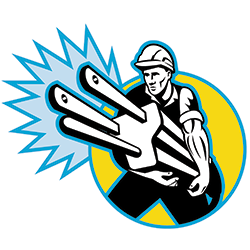 |
 Candy Adams,
Candy Adams,
CTSM, CME,
CEM, CMP, CMM,
is an independent exhibit-management
consultant, trainer, speaker, writer, and an Exhibitor conference
faculty member.
CandyAdams
@BoothMom.com
|
| |
 here are all types of trade show disasters, from broken banner stands to sick staffers. But no disaster gives me the sinking feeling I get when I arrive at the exhibit hall and follow the hanging aisle signs to find that little number next to my taped-off space - and discover the area is empty. No crates, no cases, and no cartons in sight. here are all types of trade show disasters, from broken banner stands to sick staffers. But no disaster gives me the sinking feeling I get when I arrive at the exhibit hall and follow the hanging aisle signs to find that little number next to my taped-off space - and discover the area is empty. No crates, no cases, and no cartons in sight.
The good news is that freight is very rarely permanently lost, and it usually turns up sooner or later. The bad news is that freight sometimes goes MIA and isn't ever recovered. Luckily, that's only happened to me once.
If you've been fortunate enough to escape the headache of missing freight thus far, know that it will eventually happen. And when it does, remain calm, take a deep breath, and follow these six freight-recovery steps.
 Launch an Investigation Launch an Investigation
First, check the area around your booth space. If your space is next to a no-freight aisle (an aisle on the show floor marked "No Freight" and kept clear of show freight so material handlers can deliver freight throughout the exhibit hall via forklift), your exhibit property may have temporarily been placed in an adjacent aisle.
Next, check in the booth spaces on either side of your assigned space. It's not that unusual for installation-and-dismantle (I&D) laborers, electricians, and even carpet layers to move your freight into a nearby space while they perform their jobs in your booth. If your recon mission doesn't turn up any sign of your missing freight, it's time to move on to the next step.
 Ask for Help Ask for Help
With all of your shipping paperwork (such as copies of your bills of lading and/or air-bill numbers, and tracking and PRO numbers for your shipments) in hand, head to the general service contractor's (GSC) service desk. Tell the service-desk personnel your booth number, as well as where and when your freight was set to arrive. They can check their computer system for info about your shipment, including when it arrived. If you shipped your property via the GSC (in its capacity as the official show carrier), service-desk personnel will be able to tell you where your freight was shipped (the advance warehouse or direct-to-site), and how many pieces were in the shipment.
If the freight has arrived more than a day prior, the service-desk personnel may even have the hard copies of your inbound bill(s) of lading or air waybill(s), along with the matching certified weight slips in their files.
On the off chance that service-desk personnel don't have a record of the arrival of your shipment, ask them to radio the freight foreman. The freight foreman has access to all the freight delivery records, which will tell you whether the driver has checked in at the marshaling yard, and whether he or she has been sent from the marshaling yard to the dock. The GSC's freight foreman can also notify you of any delays, and tell you if the GSC's records indicate an "aborted check-in," i.e., when a driver arrives without a certified weight slip, is sent away to get one, and has to return to the end of the move-in line.
 Call Your Carrier Call Your Carrier
If your truck has not yet checked in at the marshaling yard or dock, call your freight carrier, shipping agent, or broker. If the dispatcher/agent/broker tells you that your shipment is still in transit, ask him or her to pinpoint its location. Keep diligent notes of all the info you receive. Document the cause of the late arrival, including exactly what you were told and by whom. This information will come in handy if the late shipment results in additional material-handling fees, penalties for missing your targeted inbound time, and I&D overtime charges, for which you may be reimbursed if the charges occurred due to your carrier's failure to deliver your freight on time.
 Check the Docks and Bone Yard Check the Docks and Bone Yard
If the carrier's records indicate that your shipment has, in fact, been delivered, request the proof of delivery. With the POD in hand, head back to the GSC's service desk. Since you know that your freight has been delivered and is somewhere in the venue, ask service-desk personnel to put you in contact with the freight foreman. Tell the freight foreman who signed for the shipment and when (per your POD), and ask to speak with that person. While this seems like a shot in the dark, he or she might remember where your freight was delivered.
At the same time, ask the freight foreman where freight with missing labels ends up. Boxes, crates, and other shipments that arrive without labels are generally staged near the freight door where they were initially delivered. Depending on the amount of "orphaned freight," there might also be a separate area called a lost-freight bone yard.
 Request Backup Request Backup
So you've checked the adjacent aisles, called your carrier, consulted the freight foreman, and investigated the docks - but you're still without your exhibit properties. Now what? At this time, you'll want to enlist the help of two other groups of people to become part of your scavenger hunt: floor managers and forklift operators.
Show management often hires floor managers to assist exhibitors during setup and teardown, and if it's a large show, there may be numerous floor managers each assigned to a specific zone of the show floor. The GSC's service-desk personnel can put you in contact with the appropriate floor manager. Note that it's important not only to tell the floor manager your freight is missing, but also to ask him or her to alert all the other floor managers to your missing freight via radio so everyone can be on the lookout.
In addition to floor managers, forklift operators also make great lookouts. Flag down the drivers delivering other freight to your area of the show floor and ask them to keep their eyes peeled for your freight.
Finally, start your own aisle-by-aisle search of the trade show floor. Be methodical and look in alcoves, hallways, entrances, doorways, and behind other freight. Alert neighboring exhibitors and enlist their help in canvassing the area as well.
Recall, if you can, the number of the booth space at the last show where your exhibit properties were shipped to in case an old label wasn't removed (it happens). If you remember your last booth number, go and check that booth space to see if your crates were delivered there instead. Also look in booth spaces with numbers similar to yours, just in case your booth number was transposed (such as 343 to 434), or misread (such as 181 versus 1181 or 1811). Simple human errors like that are frustrating, but they are also relatively common and easily remedied.
If your booth number changed due to last-minute space relocation, check your original booth space as well. Also note that material-handling personnel may be using outdated exhibitor lists, and could have inadvertently delivered your freight to the wrong booth number.
 Create a Contingency Plan Create a Contingency Plan
The time you spend waiting to find out what's happened to your freight is an opportunity to start devising a backup plan in case your freight isn't found (or doesn't appear in time for the show). Ask yourself the following questions: What will it take to replace what you're missing? What exhibit properties can you "make do" with? Can you rent an exhibit from the GSC or a local exhibit house? Did you bring digital files of your graphics on a CD? Or can you access them on a shared storage drive that you could then have printed at a nearby 24-hour print shop or by the GSC? Is there another exhibit that can be shipped via airfreight from your exhibit house? Do you have a local distributor or salesperson with exhibit properties you can borrow for the show?
Keep in mind that some of the costs associated with the backup options may be covered by your freight insurance (aka valuation) policy. For example, some carriers will give you a discount on your shipping if your exhibit doesn't show up on time, but deny any other costs. (A policy covering your shipment for loss or damage while in transit should be secured before you ship your freight, and can be obtained through your corporate risk-management department, your carrier, or an outside insurance broker.) If you decide to file a claim, you'll need to know: 1) the breadth of your coverage, 2) the name and phone number of who you'll need to notify to file a claim, 3) the details and supporting paperwork needed to complete the written claim, and 4) the deadlines for both notification and filing claims.
Whether your freight turns up in the nick of time or you have to execute your backup plan, missing freight is almost an inevitable rite of passage for exhibit-marketing professionals. The first time your freight disappears, you'll be tempted to run around like a chicken with its head cut off. But if you remain calm, you're much more likely to effectively implement the aforementioned steps and craft a contingency plan that will keep you on track for success - missing freight be damned.e
|





 here are all types of trade show disasters, from broken banner stands to sick staffers. But no disaster gives me the sinking feeling I get when I arrive at the exhibit hall and follow the hanging aisle signs to find that little number next to my taped-off space - and discover the area is empty. No crates, no cases, and no cartons in sight.
here are all types of trade show disasters, from broken banner stands to sick staffers. But no disaster gives me the sinking feeling I get when I arrive at the exhibit hall and follow the hanging aisle signs to find that little number next to my taped-off space - and discover the area is empty. No crates, no cases, and no cartons in sight.  Launch an Investigation
Launch an Investigation Ask for Help
Ask for Help Call Your Carrier
Call Your Carrier  Check the Docks and Bone Yard
Check the Docks and Bone Yard Request Backup
Request Backup  Create a Contingency Plan
Create a Contingency Plan


